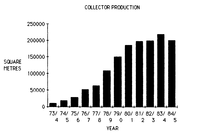


Chapter 11
I The Present Energy Economy
II Australian Energy Consumption
III Research And Development
IV Coal
V Oil And Natural Gas
VI Solar Energy
i Research and Development
ii The state of the art
iii Collectors
iv The solar water heating industry
v Industrial applications
vi Swimming pool heating
vii Building heating and cooling
viii Photovoltaics
ix Wind power
x Cooling
xi The International Solar Energy Society
VII Nuclear Energy
VIII Bagasse Firewood And Other Biomass
IX Electric Power Generation And Distribution electric Power Generation And Distribution
X Manufactured Gas
XI Industrial Process Heat
Sources
Index
Search
Help
Contact us

Collectors
Although work in the 1940s and 1950s provided a basis for the rational design of flat plate collectors, it was not until the 1970s that there was any serious attempt to measure their performance, either in controlled testing or in the field. It is now generally accepted that the critical characteristic of a collector is the heat energy it generates in relation to its installed cost, which can be conveniently expressed as megajoules generated annually per dollar cost, Annual MJ/Scost. Reliable predictions of Annual MJ requires testing of a typical collector, radiation data for its location and an agreed procedure (such as a computer programme) for calculating Annual MJ. Spme designers are using the heat table procedure developed by CSIRO, which computer hourly values of heat generation for a 6 to 8 year period of radiation records, using the measured value of efficiency from a standard test. Others use the f-chart procedure developed in USA.
The Standards Association of Australia has published a series of Australian standards for testing collectors and for the design, construction, testing and installation of solar water heaters. It is also working in conjunction with the International Stardards Organization towards agreement on international standards. At the University of New South Wales computer models of actual solar water heaters have been used to predict performance of both thermosiphon and pumped systems which are validated over long periods on their test station.
Organisations in Australian Science at Work - International Standards Organization; Standards Association of Australia; University of New South Wales
 |
Australian Academy of Technological Sciences and Engineering |  |
© 1988 Print Edition page 806, Online Edition 2000
Published by Australian Science and Technology Heritage Centre, using the Web Academic Resource Publisher
http://www.austehc.unimelb.edu.au/tia/781.html